|
Made With |
|
|
|
|
Dr. Hoffer's Travel Site This site was last updated 02/24/13 |

Saturday, July 12, 2003
Today is July 12th, and this would be my father�s 91st birthday. he died in 1957 in an automobile accident at the age of 45 when I was 13. I wish he could have seen all we have seen on these trips.
Important Note: The last posted Scandinavia Diario was #42 and was sent out on March 28, 2005. I have learned a lot about doing these pages in the past 8 years and re-edited it. Thus the remaining pages will not include huge collages with labels and will start to have links to many of the interesting people, places, hotels and restaurants. I may never get the time to upgrade the previous 41, but I am hoping I will.
also, it is very disappointing to see the quality of the 2003 photos and the fact that many of them were taken from the old video camera compared to the ones I get today but I can't go back and retake them. This website was set up in the fall of 2005 and the Scandinavia trip was just a series of emails that I added to the site later. At that time I had to save the photos in the lowest resolution so they could be sent in an email.
Now let's go back to 8 years ago in mid-July. KJH May 2011
I discovered that the text for the Scandinavia Diarios had all been Centered instead of Left-Aligned as I had originally posted them. I have no idea how this happened. The photos were floating all around due to the way I had placed them. So this week, I went through all the pages and corrected these errors. KJH September 2012
The city's population is 4,848,700. Here are some maps of the city of St. Petersburg. Below left is the city's coat of arms and on the right is the map of the governing region of St. Petersburg.

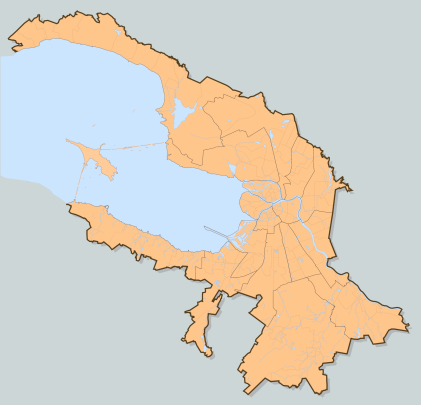
Here you can see where the city sits at the tip of Nevskaia Guba (Bay,) Pulkova Airport and Pu�kin to the south and how far Peterhof is off to the southeast.
Below you can see the Neva River through the center of the city and the many canals and waterways making the city the "Venice of the north."
Below is the very center of the city where you can see the main street Nevskij Prospeckt and the island (at the top) where Petropavloskii Sobor (Sts. Peter and Paul Cathedral) (the littlehexagon area) is located. Polina will take us there today. Again note all the waterways.
I woke up at 9:00 AM and got up at 10:30. By 10:45 I waa having a cappuccino in the hotel while working on photos. I wanted to show the currency again but with better explanation. Here again are my photos of the Russian currency. The paper bills are in denominations of 1000, 500, 100, 50, and 10 rubles.
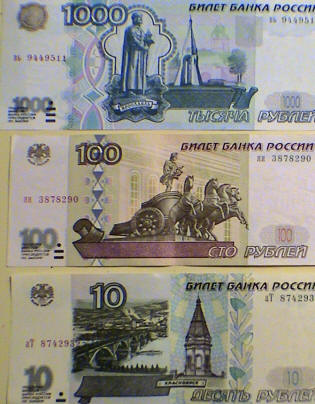
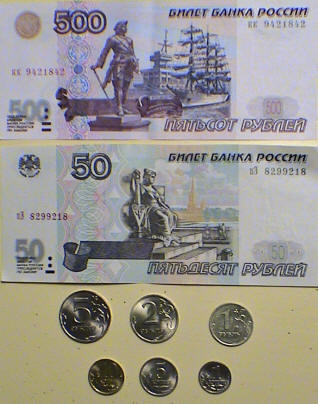
The ruble coins come in 5, 2 and 1 (upper 3) as well as in kopecks of 10, 5 and 1 (lower 3.) Above are all the front sides usually depicting people and statues; the coins having large numbers. Below are all the reverse (obverse) sides usually depicting cities and buildings; the coins having the dual eagle.
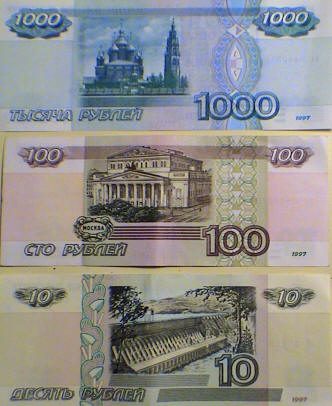
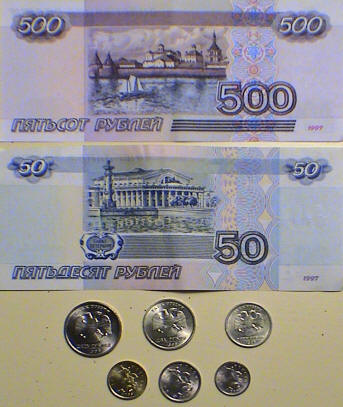
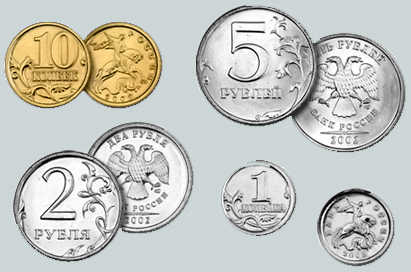
The ruble or rouble (рỳбль) is their unit of currency. Besides Russia, it is currently the currency of Belarus, Abkhazia, South Ossetia and Transnistria. One ruble is divided into 100 kopeks (коп�йка.) Historically, "ruble" was a piece of a certain weight chopped off a silver ingot (grivna,) hence the name. Below left is the front of a 5000 ruble note issued in 1997 which I never got my hands on and on the right is the 100,000 ruble note issued by Belarus in 2000. In 2003 a ruble was equal to $0.033.
[ In 2010 a ruble was equal to $0.030.]
_front.jpg)
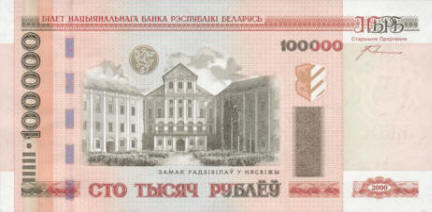
At 11:30 Marcia and I dared wander out of the
hotel on our
 own and took a walk to the famous street,
Nevsky Prospect (to
the right in photo below.) We were told to be very careful and observant. The street is very wide and the cross streets
are also quite wide as can be seen on the left below.
own and took a walk to the famous street,
Nevsky Prospect (to
the right in photo below.) We were told to be very careful and observant. The street is very wide and the cross streets
are also quite wide as can be seen on the left below.
By noon we had reached the Kazansky Cathedral (Kazanskij sobor or Our Lady of Kazan) (below.) It was overcast so the photos are somewhat dark.
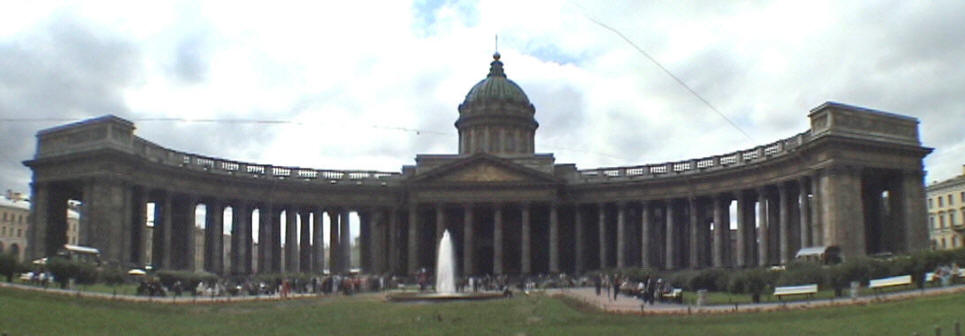
What a spectacular building. Below are stock photos of the cathedral in daylight and at night.
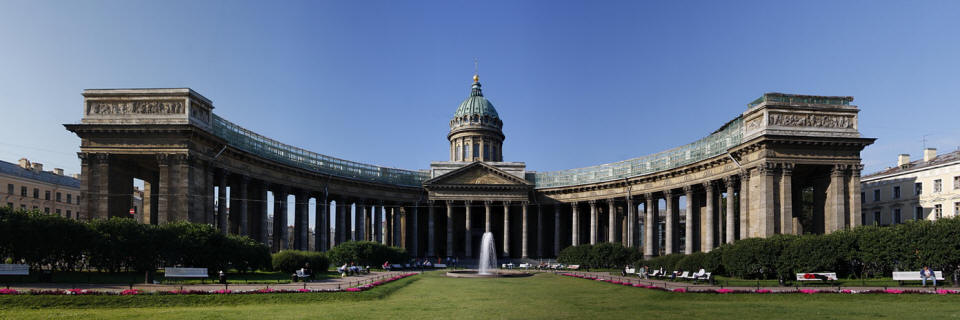

Below are two of my PhotoStitch shots as we approached the cathedral
Here are my shots from before entering the cathedral; looking at the left wing (below left) and the right wing (right.)
After Napoleon invaded Russia in 1812, and the Russian commander-in-chief Mikhail
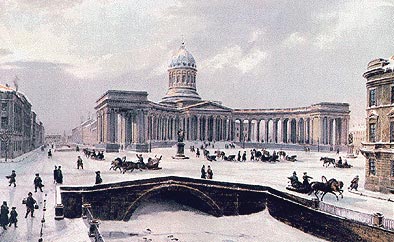 Kutuzov
asked Our Lady of Kazan for help, the church's purpose was soon to be altered.
When the "Patriotic War" was over, the cathedral was perceived primarily as a
memorial to the Russian victory against Napoleon. Kutuzov himself was
interred in the cathedral in 1813; and Alexander Pushkin wrote celebrated lines
Kutuzov
asked Our Lady of Kazan for help, the church's purpose was soon to be altered.
When the "Patriotic War" was over, the cathedral was perceived primarily as a
memorial to the Russian victory against Napoleon. Kutuzov himself was
interred in the cathedral in 1813; and Alexander Pushkin wrote celebrated lines.jpg) meditating over his sepulcher. In 1815, keys to 17 cities and 8 fortresses
were brought here by the victorious Russian army from Europe and placed in the
cathedral's sacristy. In 1837,
Boris Orlovsky
designed two magnificent
meditating over his sepulcher. In 1815, keys to 17 cities and 8 fortresses
were brought here by the victorious Russian army from Europe and placed in the
cathedral's sacristy. In 1837,
Boris Orlovsky
designed two magnificent
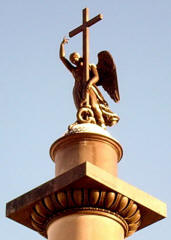 bronze
statues of Kutuzov (right) and Barclay de Tolly in front of the cathedral, one
each at the end of each wing. He also did the angel on the Alexander
Column (left.) In 1876, the first political demonstration in Russia took
place in front of the church. After the Russian Revolution of 1917, the
cathedral was closed and in 1932, it was reopened by Stalin as the pro-Marxist
"Museum of the History of Religion and Atheism." Services were resumed in
1992; and four years later the cathedral was returned to the Russian Orthodox
Church. Now it is the mother cathedral of the metropolis of St.
Petersburg.
bronze
statues of Kutuzov (right) and Barclay de Tolly in front of the cathedral, one
each at the end of each wing. He also did the angel on the Alexander
Column (left.) In 1876, the first political demonstration in Russia took
place in front of the church. After the Russian Revolution of 1917, the
cathedral was closed and in 1932, it was reopened by Stalin as the pro-Marxist
"Museum of the History of Religion and Atheism." Services were resumed in
1992; and four years later the cathedral was returned to the Russian Orthodox
Church. Now it is the mother cathedral of the metropolis of St.
Petersburg.
The exterior wide encircling arms
are made up of
96
.jpg) granite Corinthian columns, designed by
Alexander Voronikhin
(left) in
granite Corinthian columns, designed by
Alexander Voronikhin
(left) in
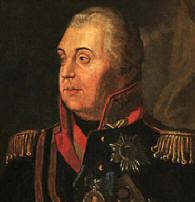 1811 to copy Bernini�s Vatican in Rome.
Regarding the large statues, let's discuss Gen.
Mikhail Kutuzov
(Mikhail Illarionovich Golenishchev-Kutuzov) first (right.) Americans are
unfamiliar with Kutuzov, but he is their famous general (in battle, below left)
who outsmarted Napoleon when he let him have Moscow (at a peace conference in
the village of
Fili,
below right) and later came back and destroyed the French Grand Arme� in 1812.
It is interesting that while fighting the Turks, Kutuzov sustained two separate
severe head wounds that ultimately led to the loss of sight in his right eye.
Note the portrait above hides his right eye. He died shortly after the war
in 1813.
1811 to copy Bernini�s Vatican in Rome.
Regarding the large statues, let's discuss Gen.
Mikhail Kutuzov
(Mikhail Illarionovich Golenishchev-Kutuzov) first (right.) Americans are
unfamiliar with Kutuzov, but he is their famous general (in battle, below left)
who outsmarted Napoleon when he let him have Moscow (at a peace conference in
the village of
Fili,
below right) and later came back and destroyed the French Grand Arme� in 1812.
It is interesting that while fighting the Turks, Kutuzov sustained two separate
severe head wounds that ultimately led to the loss of sight in his right eye.
Note the portrait above hides his right eye. He died shortly after the war
in 1813.
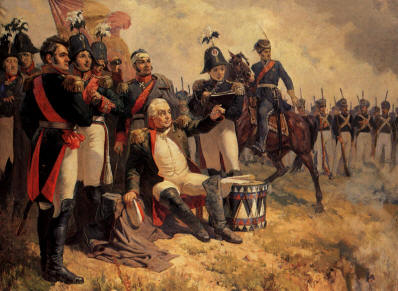
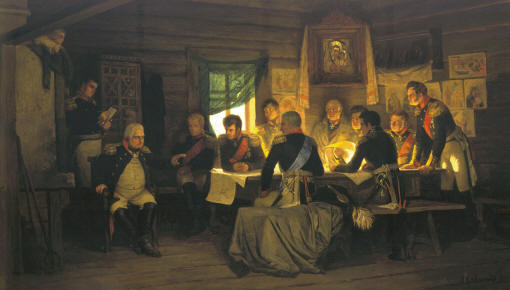
Below left is a memorial to Kutuzov in Moscow. Incidentally, he is mentioned in Leon Tolstoy�s (Lyev Nikolayevich Tolstoy or Лeв Никол�евич Толст�й) "War & Peace." Below center is Tolstoy and on the right is the only shot of him in color taken in 1908 (2 yrs before his death) by ...

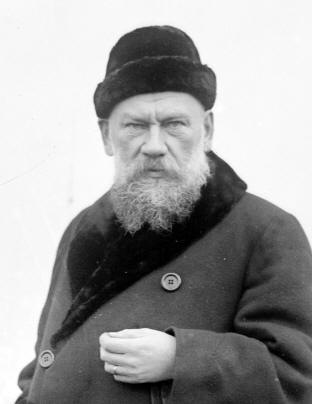

... Sergey Prokudin-Gorsky (below left,) a pioneer in color photography and documenter of Tsarist Russia in the early 1900s. Below right is a stamp honoring Tolstoy issued by the Soviets in 1978.
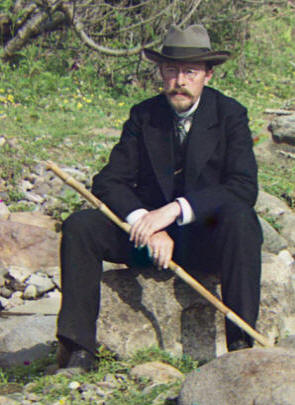
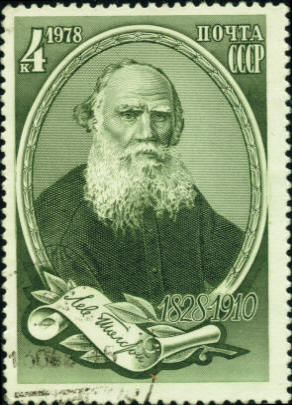
At the end of the other wing of the Cathedral there is the
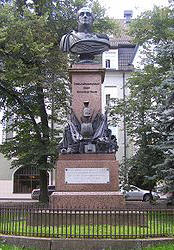
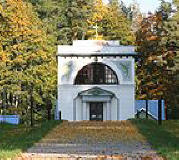 statue
of Prince Michael
Andreas Barclay de Tolly (1761-1818) (below left.) He was a member of
the Scottish Clan Barclay and born in Pamū�is in present-day �iauliai County,
Lithuania but he was raised in Livonia, which was then a part of the Russian
Empire (currently divided between Estonia and Latvia.) He became a Russian
Field Marshal and Minister of War during Napoleon's invasion of Russia in 1812
and subsequent campaigns of the Russian army in Europe. His mausoleum
(above right) is in Estonia and there is a memorial statue (above left) to him
in Tartu, Estonia. The statue here (below center) was erected at the
behest of
Emperor Nicholas I.
statue
of Prince Michael
Andreas Barclay de Tolly (1761-1818) (below left.) He was a member of
the Scottish Clan Barclay and born in Pamū�is in present-day �iauliai County,
Lithuania but he was raised in Livonia, which was then a part of the Russian
Empire (currently divided between Estonia and Latvia.) He became a Russian
Field Marshal and Minister of War during Napoleon's invasion of Russia in 1812
and subsequent campaigns of the Russian army in Europe. His mausoleum
(above right) is in Estonia and there is a memorial statue (above left) to him
in Tartu, Estonia. The statue here (below center) was erected at the
behest of
Emperor Nicholas I.
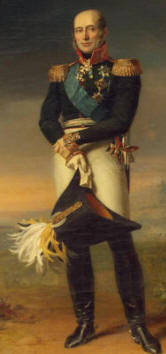
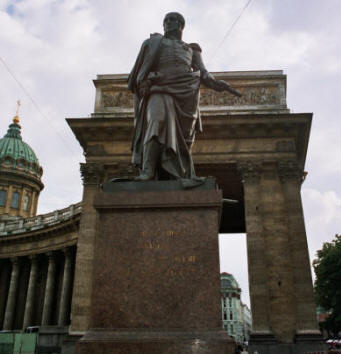
.jpg)
Above right is the west entrance to the cathedral. Today the cathedral is
dedicated to an icon entitled "Our Lady of Kazan"
the original of which
disappeared in 1904. It is a holy icon of the highest stature within the
Russian Orthodox Church, representing the Virgin Mary as the

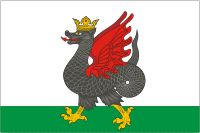 protector
and patron of the city of
Kazan (Казань,) which is the capital of the Republic of Tatarstan.
It's city flag (right) and coat of arms (left) are kind of cartoonish. The
icon was discovered on July 8, 1579, underground in the city of Kazan by a
little girl named Matrona. Kazan (below) is on the Volga River and is Russia's 8th
largest city and appears quite beautiful.
protector
and patron of the city of
Kazan (Казань,) which is the capital of the Republic of Tatarstan.
It's city flag (right) and coat of arms (left) are kind of cartoonish. The
icon was discovered on July 8, 1579, underground in the city of Kazan by a
little girl named Matrona. Kazan (below) is on the Volga River and is Russia's 8th
largest city and appears quite beautiful.

According to tradition, the location of the image was revealed to her by Theotokos (the Blessed Virgin Mary,) in a Marian apparition. The original icon (below left) was kept in the Theotokos Monastery (below right) of Kazan built to commemorate the spot where it had been discovered.
![]()
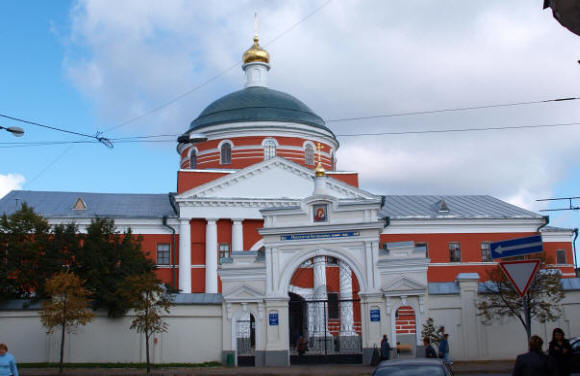
We entered the cathedral doors and stepped inside this massive structure. There are many icons inside and it very strange for a Roman Catholic to watch the absolute devotion the people have to these paintings. It appears as if they are worshipping the object rather than who the picture depicts, though I must admit I have seen Roman Catholics do similarly with statues. Photography and video were absolutely forbidden, but here is what it looks like inside (below left) from the photos I took, many of which are slightly angled while doing it surreptitiously. I had to do a lot of straightening and Photoshop to get even what there is below. Below right is an example of an icon sitting atop its pedestal.

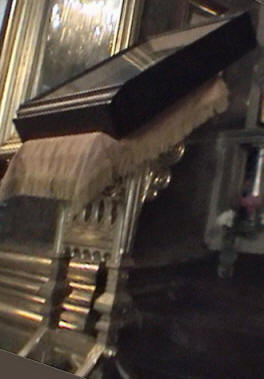
The floor was entirely covered in beautiful marble.

Below left you can see a set of gilded icons.
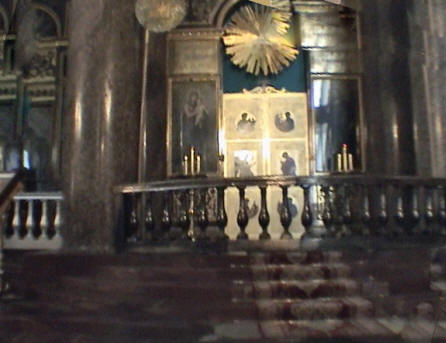
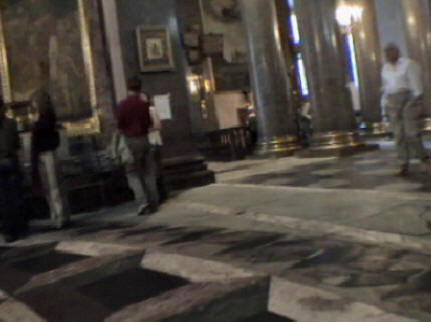
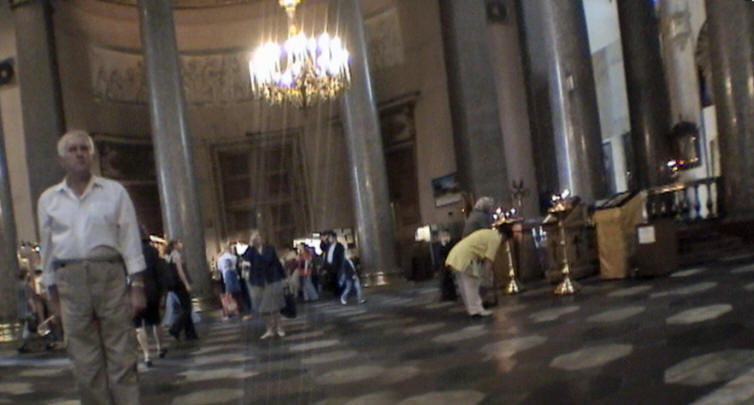
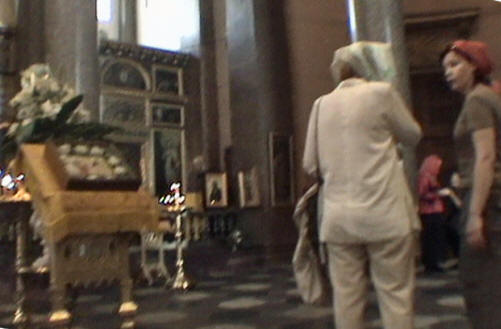

I now neared the area of the Royal Doors where the important icon is. You can see the people lining up in the photo below left.
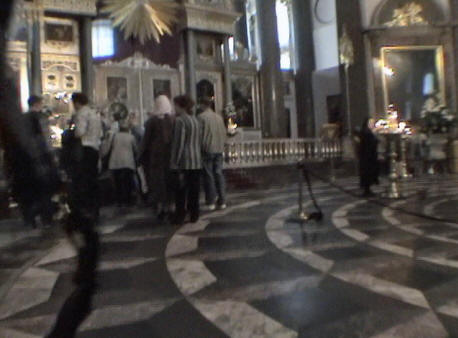
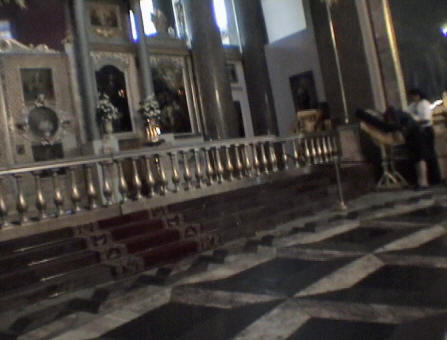
It is located in this spectacular area with a huge dome above.
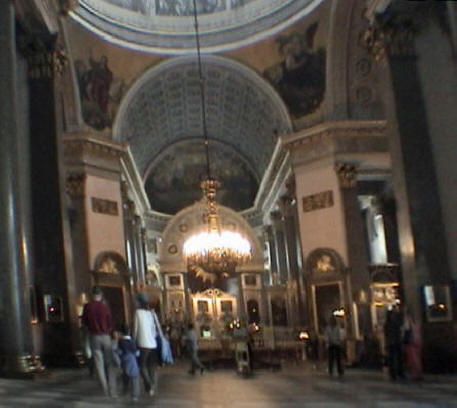
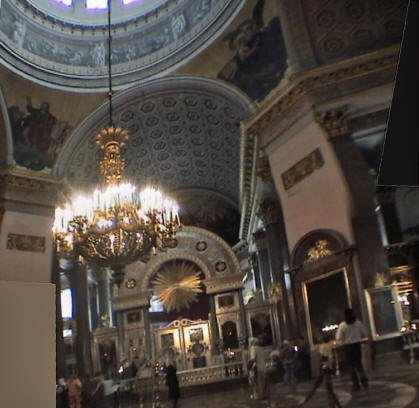
You can just barely see this Iconostasis of Kazan Cathedral. The Icon of Our Lady of Kazan is to the left of the Royal Doors, above the head of the lady in the white dress (below left.) Sorry I couldn't get a better photo.
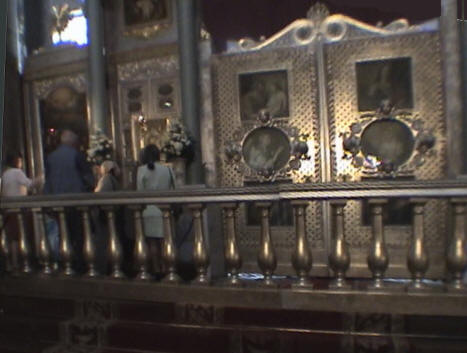

Below left is a blurry stock photo of the Icon.
![]()
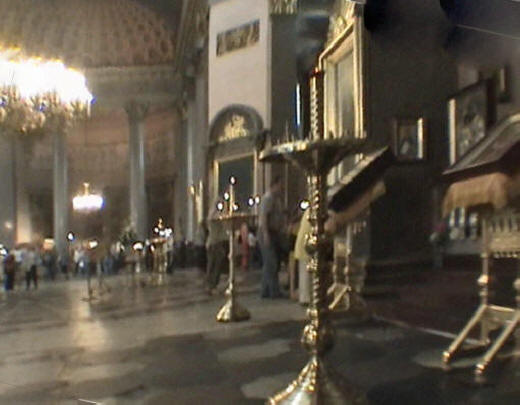
Here are scenes as you leave this area.
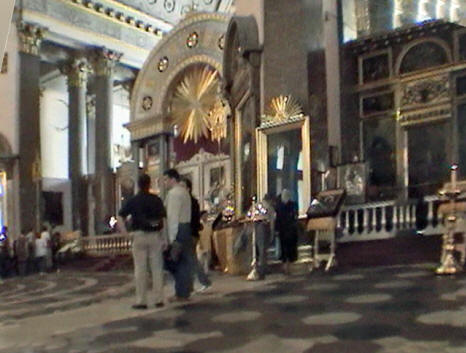

The various flooring and columns were very impressive as well.

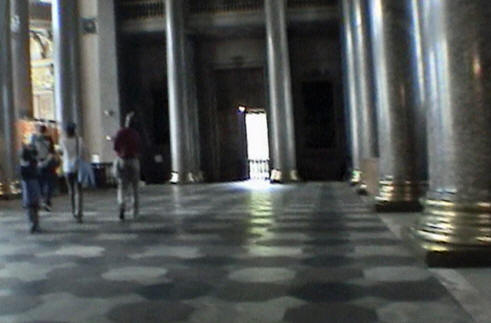
Near the entrance, there is the obligatory shop which many churches in Europe have that sell souvenirs and religious items and books.
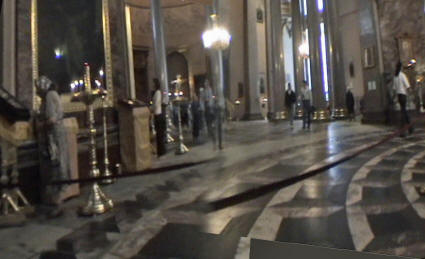
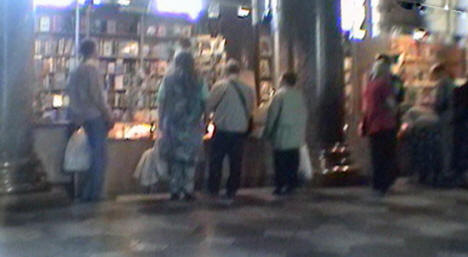
We finally walked outside and I saw these statues of Christ on the side of the building.
At 1:00 we left and crossed the street and continued down Nevsky Prospekt.
We were to meet Polina to get a cappuccino at Sadko�s Caf� in the front of the Grand Hotel Europe [Nevsky Prospekt, Mikhailovskaya Ulitsa 1/7, +7-812-329-6000; US 800-237-1236] (below,) the most famous hotel in the city.
As can be seen, the hotel is on the corner of Mikhailovkaya ulitsa (street) and Nevsky Prospect and is now under joint Swedish/Russian management. It was built in 1873-5 and the art deco interior redecoration in 1909 was done by the Swedish-Russian Nouveau architect Fyodor Lidval. The hotel was featured in the 1995 James Bond movie "Golden Eye" though not actually shot here. It vies with Corinthia Nevskij Palace Hotel and Hotel Astoria for the title of the most luxurious five-star hotel in St. Petersburg. Below is a shot I took of the caryatids on the outside of the hotel.
Polina (below left) joined us at 1:30 to go over her plans for the rest of our stay and have lunch with Marcia.
While they had lunch, I wanted to wander around this great hotel and see what it looked like Below is a stock photo of their world-class restaurant called L'Europe, stated to be the best restaurant in the city.
Here are my shots of the main floor hallways.
And when you make a left, their are fancy hallways leading to the check-in desk.
After finishing my explorations, I joined the ladies back on the terrace and took this shot (PhotoStitch) of the huge building across the street.
This is one of the major train stations in St. Petersburg. Below is a photo I found of Moscow Station and the Russian flag flying; a helicopter going overhead.
There are four major train stations in the city. The Moscow Station has trains to Moscow, the far north, Crimea, the Caucasus, Georgia, Central Asia and suburban lines to the South-East. Finland Station goes to Helsinki, Vyborg and suburban lines north. Vitebsk Station has trains to Smolensk, Belarus, Kiev, Odessa, Moldova, Pushkin, Pavlovsk and suburban lines to the south. Warsaw Station goes to the Baltic states, Pskov, Lviv (Lvov) and Eastern Europe. There is also the Baltic Station which goes west and to the Baltics.
We left the hotel and to cross Nevsky Prospect you have to go into an underground tunnel which was surprisingly quite clean. There are many shops down there and I got this shot of some of the local beer which sell for 20 rubles ($0.65.)
We aren't far from the river so I included this PhotoStitch panorama of photos I took of the city on the other side.
Above is a sport shop we went past. Below are shots I took of some of the buildings.
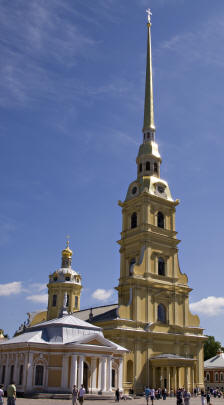
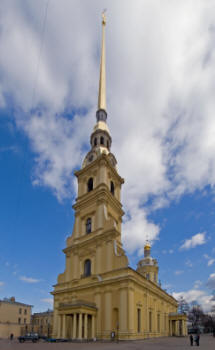 Above left and below is a sign advertising
Megafon,
the company whose phone chip we purchased. Polina then took
us in her car and drove us across the river to
the little island to tour the great Cathedral with its tall spire. The
Sts. Peter and
Paul Cathedral (right, above right) is a Russian Orthodox cathedral located
inside the Peter
and Paul Fortress. It is the first and oldest landmark in St.
Petersburg, built between 1712 and 1733 on
Zayachy Island (Hare
Island) in the Neva River (below.)
Above left and below is a sign advertising
Megafon,
the company whose phone chip we purchased. Polina then took
us in her car and drove us across the river to
the little island to tour the great Cathedral with its tall spire. The
Sts. Peter and
Paul Cathedral (right, above right) is a Russian Orthodox cathedral located
inside the Peter
and Paul Fortress. It is the first and oldest landmark in St.
Petersburg, built between 1712 and 1733 on
Zayachy Island (Hare
Island) in the Neva River (below.)
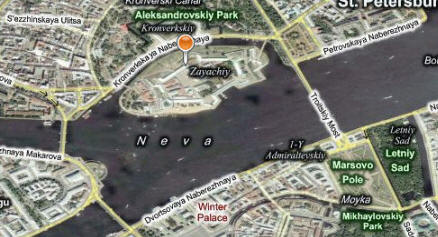 Both
the cathedral and the fortress were originally built under Peter the Great and
designed by Domenico
Trezzini (a Swiss Italian architect.) The cathedral's bell tower is
the world's tallest Orthodox bell tower. Since the belfry is
not standalone, but an integral part of the main building, the cathedral is
sometimes considered the highest Orthodox Church in the world.
Both
the cathedral and the fortress were originally built under Peter the Great and
designed by Domenico
Trezzini (a Swiss Italian architect.) The cathedral's bell tower is
the world's tallest Orthodox bell tower. Since the belfry is
not standalone, but an integral part of the main building, the cathedral is
sometimes considered the highest Orthodox Church in the world.
Click here to see many of the beautiful Orthodox churches in the world.
Below right is a stock photo of the island and the A in the map on the left points to the Cathedral.
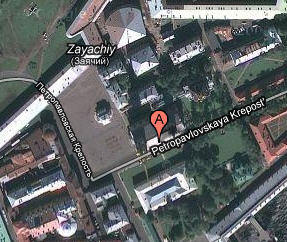
.jpg)
Below are a series of shots I took of the building from different angles.
Below right is a close-up of the front entrance where we went in.
It is a major attraction because it contains the tombs of most of the Russian tsars including the first one (Peter the Great;) the last ones (Nicholas I & II and family) and many of those in between. It is quite spectacular and the historical significance was not lost on us. Below is a large schema of the family tree of the tsars.
As we entered, there was a choir of five singing hymns. On the right you can see the Russian cross and how it appears on the tombs.
As you enter the church you can see the people lining up to see the tombs.
There are photographs displayed of descendents of the Romanovs (the ruling family of the Tsars,) both of them living in the US.
You then enter into this beautiful place.
The halls and ceilings were quite something. I caught a shot of Marcia in left photo.
Then you get to the area where all the tombs of the Romanov family are.
Here are the tombs of Tsar Nicholas II and his family (below) whose bodies were recently removed from the pit they were dumped into after they were shot during the 1917 Bolshevik revolution. The names listed (above, L-R) are Alexei, Olga and Tatiana. Below is the entire family in better times.
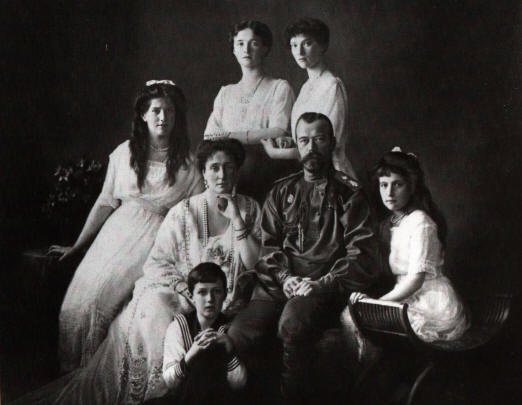
Nicholas II
(1868�1918) (Николай II, Николай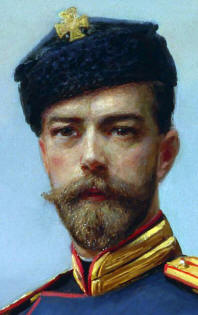
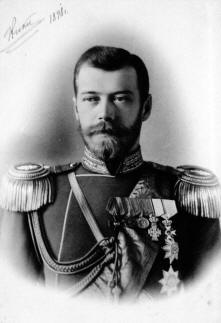 Александрович
Романов, Nikolay II, Nikolay Alexandrovich Romanov) was the last Emperor of
Russia, Grand Prince of Finland, and titular King of Poland.
Nicholas II (left & right) ruled from 1894 until his abdication on March 15,
1917. His reign saw Imperial Russia go from being one of the foremost
great powers of the world to economic and military collapse. Critics
nicknamed him Bloody Nicholas because of the anti-Semitic pogroms that occurred
during his reign. Under his rule, Russia was defeated in the
Russo-Japanese War.
Александрович
Романов, Nikolay II, Nikolay Alexandrovich Romanov) was the last Emperor of
Russia, Grand Prince of Finland, and titular King of Poland.
Nicholas II (left & right) ruled from 1894 until his abdication on March 15,
1917. His reign saw Imperial Russia go from being one of the foremost
great powers of the world to economic and military collapse. Critics
nicknamed him Bloody Nicholas because of the anti-Semitic pogroms that occurred
during his reign. Under his rule, Russia was defeated in the
Russo-Japanese War.
%20(2).png) As
head of state, he approved the Russian mobilization of August 1914, which marked
the first fatal step into WWI and thus into the demise of the Romanov dynasty
less than three years later.
As
head of state, he approved the Russian mobilization of August 1914, which marked
the first fatal step into WWI and thus into the demise of the Romanov dynasty
less than three years later.
His father stupidly mandated that he would not be educated until age 30 and of course, his father died when Nicholas was 26. No wonder he became such a disaster. Nicholas had only one son, little Alexei (below left,) who inherited the "Royal disease" haemophilia (bleeder.) There was no cure at that time so this is how the infamous Grigori Rasputin (center,) a Siberian mystic, began to have such great influence over his mother and later Nicholas himself. He led them to believe he was treating and helping the boy.

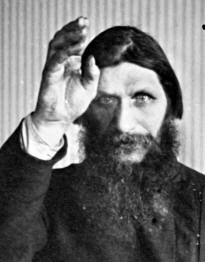

Above right is an example of Russian coinage of 1898 with Nicholas' face on it. He abdicated following the February Revolution of 1917 during which he and his family were imprisoned, first in the Alexander Palace at Tsarskoye Selo, then later in the Governor's Mansion in Tobolsk, and finally at the Ipatiev House in Yekaterinburg. Nicholas II, his wife, his son, his four daughters, the family's medical doctor, the Tsar's valet, the Empress' lady-in-waiting and the family's cook were murdered in the same room by the Bolsheviks on the night of July 17, 1918.
The executioners drew revolvers and the shooting began. Nicholas was the first to die; Yurovsky shot him multiple times in the chest. The 4 daughters survived the first hail of bullets because they were wearing over 2.86 lbs (1.3Kg) of diamonds and precious gems sewn into their clothing, which provided some initial protection from the bullets and bayonets. They were then stabbed with bayonets and then shot at close range in the head. Below are photos of the 4 girls; (L-R) Olga, Tatiana, Maria and Anastasia.
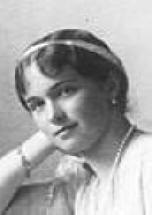
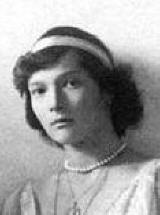

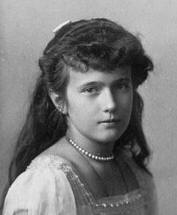
In 1979, the bodies of Tsar Nicholas II, Tsarina Alexandra, three of their daughters, and others killed with them, were discovered near Sverdlovsk by amateur archaeologist Alexander Avdonin. They later built this "Church on the Blood," in Yekaterinburg on the spot where the Ipatiev House once stood (below left.)
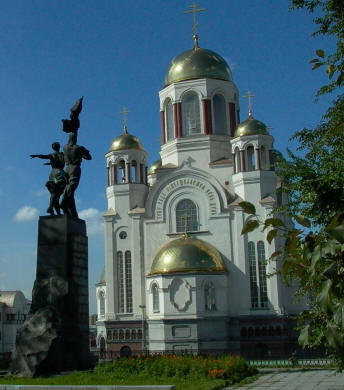

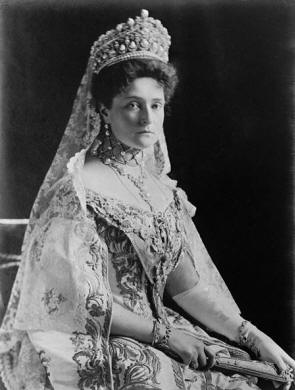
Above right is a photo of Tsarina Alexandra Fyodorovna (Императрица Александра Фёдоровна Романова) who was Alix of Hesse (Germany) and a granddaughter of Queen Victoria of England. She always looks rather stern.
In January 1998, the remains excavated from underneath the dirt road near Yekaterinburg were officially identified as those of Nicholas II and his family (excluding one of the sisters, and the boy Alexei.) The identifications by separate Russian, British and American scientists using DNA analysis concurred and were found to be conclusive. After the testing, the remains were finally interred here at the Cathedral on July 17, 1998, 80 years after they were executed (just 5 years ago.) Below left is a photo of "Nicky and Alix" in 1903 at the last Palace costume ball dressed in Russian garb. Below right the names listed (L-R) are Nicholas II, Alexandra (his wife,) and daughters Maria and Anastasia.
.jpg)
These are my photos of this special memorial to their remains.
Here is a stock photo I found on the web.
.jpg)
Below is a blowup I took of the icons on the wall and the separate tomb.
Most of the tombs are in white marble with a metal cross on top.
Some of the other tombs were in red or black marble.
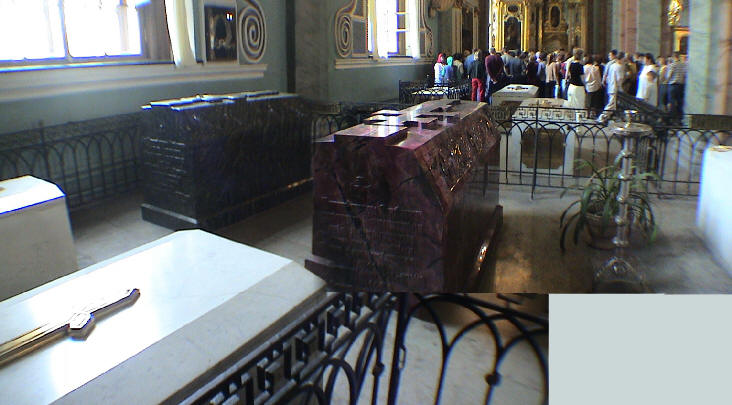
Below is the gilded pulpit from the left side (left,) from the right side (right) and a close up (center.)
Here is a shot facing the main altar (left,) then looking above it (center) and a similar stock photo I found on the web (right.)
.jpg)
Here are photos I took of the dome above the main altar which is also quite spectacular.
The artistic workmanship on the side walls was also very beautiful.
Here are my shots of the Holy Doors and the 4th is one I found on the web.
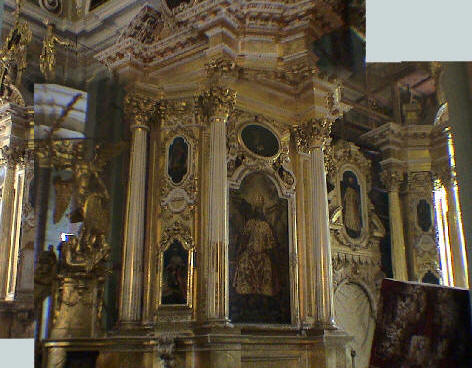
.jpg)
 Up
in the belfries, the Peter and Paul carillon is a gift to St. Petersburg from
the
Government of Flanders, and also more than 350 sponsors from different
countries of the world. Flanders is the Dutch-speaking northern half of
Belgium (red area in map below, flag left.)
Up
in the belfries, the Peter and Paul carillon is a gift to St. Petersburg from
the
Government of Flanders, and also more than 350 sponsors from different
countries of the world. Flanders is the Dutch-speaking northern half of
Belgium (red area in map below, flag left.)

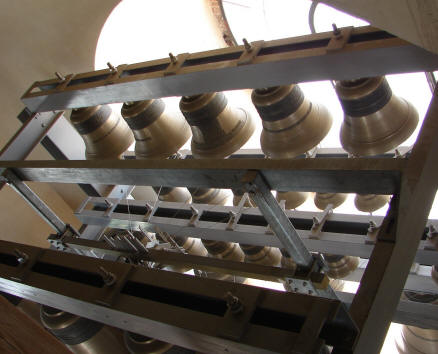


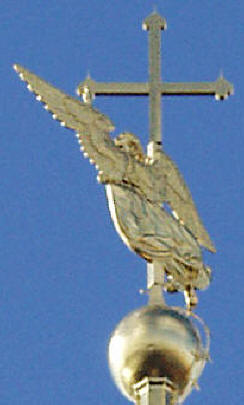
Above center is a stained glass window. When renovators were working to clean the angel upon the spire (above right) in 1997, they found a note in a bottle left in one of the folds of the angel's gown. In the note, renovators from 1953 apologized for what they felt was rushed and shoddy work because Soviet premier Nikita Khrushchev wanted the angel refurbished for the 250th anniversary of the city that year. It is said that the renovators in 1997 left another message for future generations, but the contents of that message have not been revealed. Below are stock photos I found on the internet.
.jpg)
.jpg)
But here are the tombs of the most important figures in Russian history. First is that of Peter the Great, who founded this city named after him. Note the medallions on the top (below left.) There is also a bronze bust of him (below right.)
Peter I the Great
(right) or Pyotr Alexeyevich Romanov (Пётр Алекс�евич Ром�нов, Pyotr I,
 or Пётр
Вели�кий, Pyotr Velikiy) (1672�1725) ruled Russia and later the Russian Empire
from May 7, 1682 (at age 10) until his death. He ruled jointly before 1696
with his weak and sickly half-brother, Ivan V. Standing at 6 ft 8 in (200
cm) in height, the Russian Tsar was literally head and shoulders above his
contemporaries both in Russia and throughout Europe. He spent much time
traveling in Western Europe and especially in Holland. From this he was
very much influenced by Western culture and architecture. He carried out a
policy of modernization and expansion that transformed the Tsardom of Russia
into a 3 billion acre Russian Empire and a major European power.
or Пётр
Вели�кий, Pyotr Velikiy) (1672�1725) ruled Russia and later the Russian Empire
from May 7, 1682 (at age 10) until his death. He ruled jointly before 1696
with his weak and sickly half-brother, Ivan V. Standing at 6 ft 8 in (200
cm) in height, the Russian Tsar was literally head and shoulders above his
contemporaries both in Russia and throughout Europe. He spent much time
traveling in Western Europe and especially in Holland. From this he was
very much influenced by Western culture and architecture. He carried out a
policy of modernization and expansion that transformed the Tsardom of Russia
into a 3 billion acre Russian Empire and a major European power.
Above left is the tomb of his wife Catherine I. Here is a better photo of Peter I found on the internet.

The memorials and statues of Peter are all over Russia but here are ones I found that are in St. Petersburg; left, the famous mounted one in front of St. Isaac's Church and another depicting him as a shipbuilder.


The second most important tomb is that of
Catherine the Great
or Catherine II (Екатерина II
important tomb is that of
Catherine the Great
or Catherine II (Екатерина II
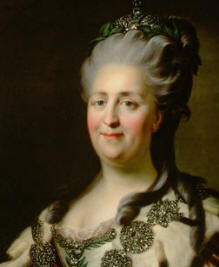
%20(2).png) Великая,
Yekaterina II Velikaya.) She (right, below left) was born in Stettin,
Pomerania, Prussia on May 2,
1729 as Sophie Friederike Auguste von Anhalt-Zerbst-Dornburg. She reigned
as Empress of Russia from July 9, 1762
Великая,
Yekaterina II Velikaya.) She (right, below left) was born in Stettin,
Pomerania, Prussia on May 2,
1729 as Sophie Friederike Auguste von Anhalt-Zerbst-Dornburg. She reigned
as Empress of Russia from July 9, 1762
 after the assassination of her husband,
Peter III, just after the end of the
Seven Years' War
until her death on November 17, 1796. Under her direct auspices, the
Russian Empire expanded, improved its
administration, and continued to modernize along Western European
lines,
as started by Peter the Great. Catherine's rule re-vitalized Russia, which
grew stronger than ever and became recognized as one of the great powers of
Europe. She had successes in foreign policy and oversaw sometimes brutal
reprisals in the wake of rebellion (most notably
Pugachev's Rebellion.)
after the assassination of her husband,
Peter III, just after the end of the
Seven Years' War
until her death on November 17, 1796. Under her direct auspices, the
Russian Empire expanded, improved its
administration, and continued to modernize along Western European
lines,
as started by Peter the Great. Catherine's rule re-vitalized Russia, which
grew stronger than ever and became recognized as one of the great powers of
Europe. She had successes in foreign policy and oversaw sometimes brutal
reprisals in the wake of rebellion (most notably
Pugachev's Rebellion.)
Below left is her tomb and on the right, that of Catherine I.
We finally finished our tour and Polina led us outside where there is a large bronze statue of Peter the Great by Mikhail Shemyakin (below right.) On the left is my photo and on the right is a stock photo I found.
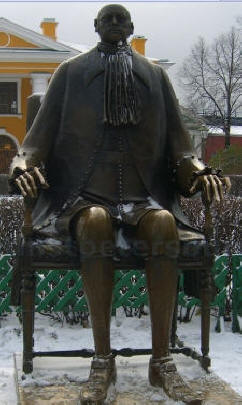
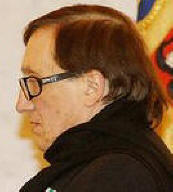
At 3:00 PM, Polina then drove us 16 miles south of the city to the little town named
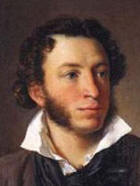 after the famous writer,
Alexander Pu�hkin
(left.) He was the father of Russian literature and is highly revered.
His problems with his wife are legendary and you can look it up.
after the famous writer,
Alexander Pu�hkin
(left.) He was the father of Russian literature and is highly revered.
His problems with his wife are legendary and you can look it up.
This town is where the Pu�hkin Catherine Palace was built. Its previous name prior to 1937 was Tsarskoie selo which means Royal Village. The palace was built for Peter the Great�s wife Catherine I (the Lithuanian washwoman.) In 1744 it was remodeled by the Italian architect Rastrelli for Catherine's daughter Elisabeth. Below, as we entered, is the large gate to the property.
It is a huge and impressive palace with its blue and white fa�ade and gold cupolas on the Palace Church. The many large tour buses from the cruise ships had just deposited hundreds of tourists who are standing in very long lines in the heat and also waiting inside in sweltering hallways for hours.
The gilded-gold statues all along the building were just beautiful.
They used 30 lbs (476 oz) (13.6Kg) of gold to gild the place.
[This is worth almost $738,000 in 2011.]
When you go through the building to the other side you can see the large gardens in the back.
As you can see, this is all quite impressive.
Below is a stock photo of the north side of the building I found.
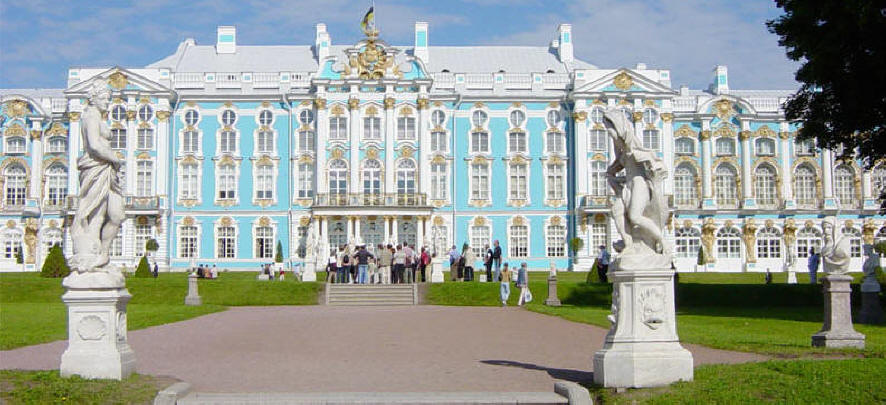
It seemed impossible that we would ever get in even after waiting for hours. But then Polina worked her magic (below left) and paid the attendants to sneak us ahead of everyone by going in through the exit. This saved us hours of torture in this heat. There was a gentleman playing a piccolo for the hoards waiting outside.
Here is a layout I found of the first floor floorplan.

We entered the main building and climbed the Grand Staircase (11 above) to the main floor.
Marcia and Polina walk into the huge Grand Ballroom with many windows covered in gilded decorations.
Below is a photo I found on the web of this room when its empty.
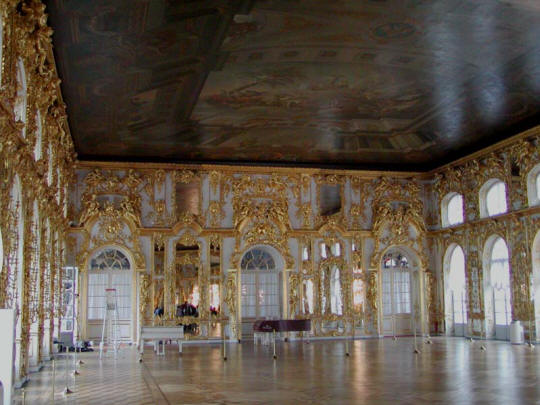
Here are more of the photos I took.
To continue the tour you then go from room to room (below left) and you can see from the number of door jambs, there are many to go through.
Many of the ceilings are beautifully painted.
The most famous room is the Amber Room which is made entirely of what else; amber. Before going in we had to put on "reusable" shoe covers.
The original Amber Room
represented a joint effort of German and Russian
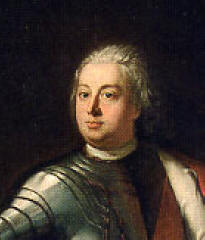 craftsmen
which was constructed from 1701-9 in
Prussia and installed at
Charlottenburg
Palace.
craftsmen
which was constructed from 1701-9 in
Prussia and installed at
Charlottenburg
Palace.
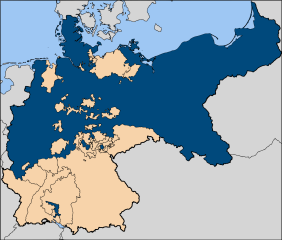 Prussia
is this big blue area on the map (right) during its greatest extent overlying
present day Germany (pink.) The
dark green (below left) is the part of Prussia that makes up present day
Germany. The reason this is so important to the Russian people is that in
1716 the Amber Room was a gift from the Prussian king
Friedrich Wilhelm I (1688�1740) (above left,) of the
Hohenzollern dynasty, to his then ally, Tsar Peter the Great.
Prussia
is this big blue area on the map (right) during its greatest extent overlying
present day Germany (pink.) The
dark green (below left) is the part of Prussia that makes up present day
Germany. The reason this is so important to the Russian people is that in
1716 the Amber Room was a gift from the Prussian king
Friedrich Wilhelm I (1688�1740) (above left,) of the
Hohenzollern dynasty, to his then ally, Tsar Peter the Great.
In 1755, Tsarina
Elizabeth I (right) (1709�1762 ) (daughter of
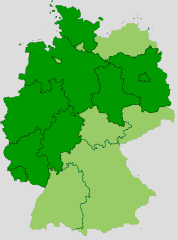 Peter
and Catherine I) had it transferred and installed,
Peter
and Catherine I) had it transferred and installed,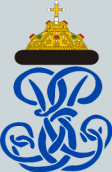
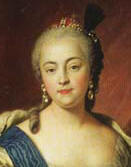 first
in the Winter Palace, and then here in Catherine Palace. The room covered
more than 592 ft2 (55 m2) and contained over six tons of
amber. It is an irony that the
whole room was stolen by the German Nazi army in 1944 and there are many
controversial theories of what happened to it. Read about it by clicking
here. Below is a
photo I found of what it looked like prior to WWII and its destruction.
first
in the Winter Palace, and then here in Catherine Palace. The room covered
more than 592 ft2 (55 m2) and contained over six tons of
amber. It is an irony that the
whole room was stolen by the German Nazi army in 1944 and there are many
controversial theories of what happened to it. Read about it by clicking
here. Below is a
photo I found of what it looked like prior to WWII and its destruction.

Then, only recently, thanks to some large German companies (especially Ruhrgas AG,) the whole room was completely restored. This year is the first time it has been available to the public and it is a big deal for the Russian people and another cause for the huge lines. The sign below describes this in 3 languages.

The reconstruction work started in 1979 and was only completed this year (2003) on the 300th anniversary of the founding of St. Petersburg. President George W. Bush was brought here by President Putin a couple of months ago. As you enter the room, it is spectacular in its opulence. Photography is not allowed but you will see I wasn't the only one.
Below left is a stock photo and then a series of close-up shots I took to show the details of the amber pieces and some of the artwork.
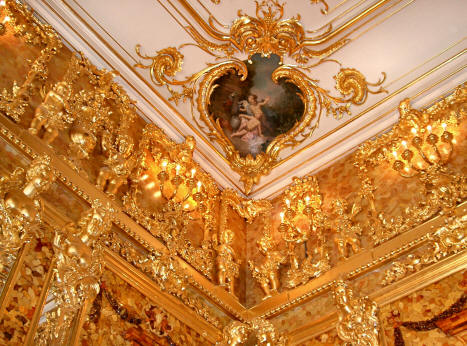
Then we started looking at all the other rooms. Note the paintings on the ceiling.
Above and below is one example of a dining room.
Below left is not a mirror. It is looking through the doorway seeing the many other doorways ahead. You just keep going from room to room.
Above right and below is another dining room.
Below is a close up of the table (left) and the furniture (right.)
Note below left the floor to ceiling ceramic heating unit in the corner.
Below you can see me in the mirror using the video camera to take these photos.
This room (below) has a display of a dress from the period.
Above is another heating unit and a photo of a ceiling painting. Below is Polina (left) and an example of elaborate ornamentation in this room.
Above is a room with green panels and below one with red panels.
Below is just an example of the many works of art.
Here Marcia is examining the fine detail in this room.
Look how elaborate this ceiling is.
We then entered a room which was ceiling to wall paintings with no area of bare wall showing. Quite a feat of placement.
Here are photos I found of some of the areas I did not get to photograph. Below left is a photo of the Agate Rooms and below right is the Court Chapel called the Ukhtomsky Church.
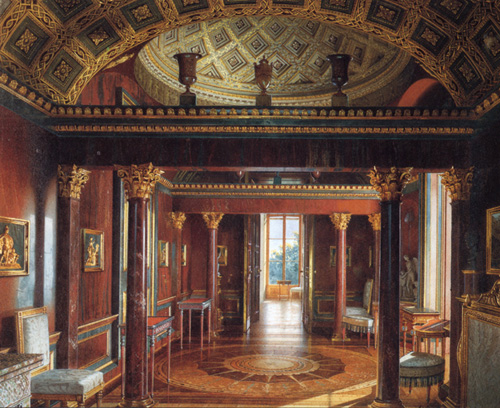
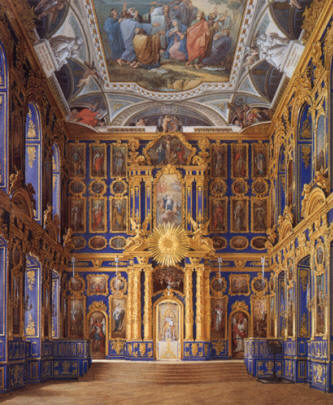
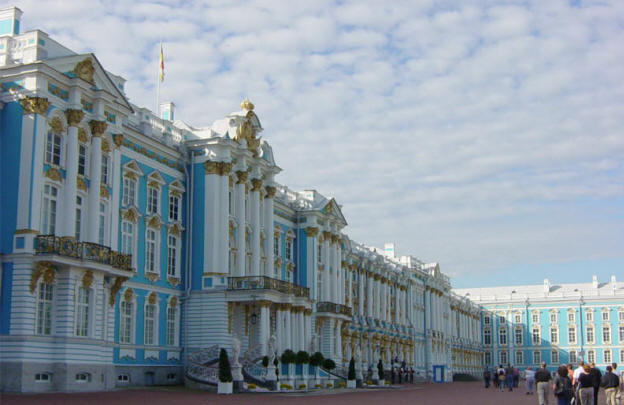
And finally a stock photo I found of the south side. After touring all of the palace, at 5:30, Polina drove us to this special pectopah (restaurant) called �Podvorje� ('Russian Village') in a nearby town called Tsar. Below is her Mercedes and her Russian license plate.
As you can see it is quite a unique place with its rooster sitting at the top.
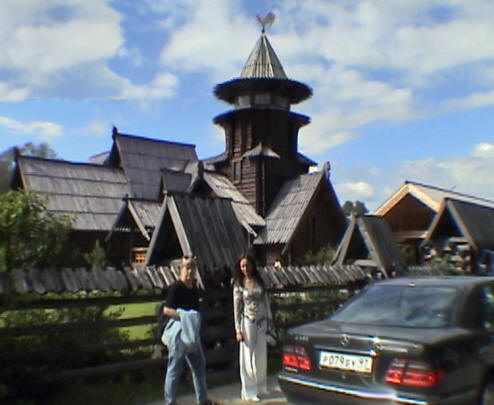
As we walked inside, the place was huge with many wooden tables.
There was a lot of interaction between Polina and our aptly dressed waiter. I think he was flirting with her.
The complexities of the menu plus the language gave quite a challenge to Marcia in figuring out what she was going to have.
While I left them handling that challenge, I went to the men's room and changed into my running gear and went for my run on a park trail near the restaurant that was just wonderful. You can see the woods I ran in behind the police car parked out front.
When I got back, I changed in the men's room and the Balkina (БАЈІΤИКА) beer was refreshing and greatly appreciated.
At 6:45, with Polina's help, we order our dinner which wound up being a panoply of typical Russian country food starting with a beautiful borscht (below left) and a salad (below right.)
Then they brought these little bread pretzels and a plate of french fries.
It just kept coming, plate after plate.
There was beef stroganov (below left) and pickled herring (below right.)
There was also some very good lamb chops (below right.)
I believe the dish below (left) is sardines with carrots.
There were these meat patties with potatoes (below left) and nice slices of tender pork loin with horseradish (below right.)
The piece d'resistance for me was the roast duck served with a half-baked stuffed apple.
It was all very good, can you believe we ate all this? I think Polina was trying to make sure we tasted everything Russian item on the menu. We then listened to the Russian folk music (below) in the main hall and then left at 10:40 PM for the drive back to our hotel in the city.
On the way we stopped at the St. Petersburg's Pulkovo airport and met a friend of Polina's named Lenya.
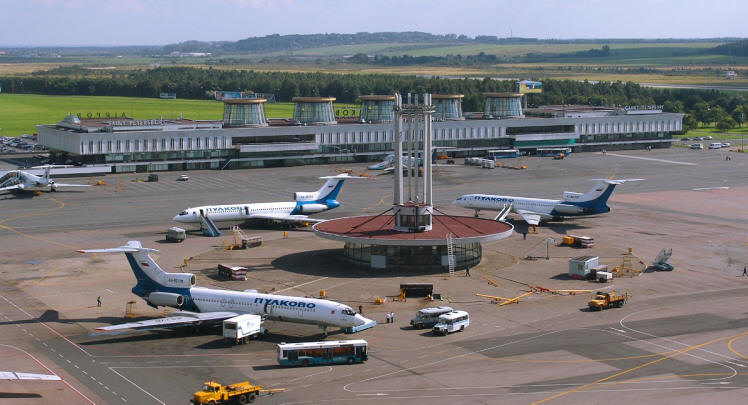
Above is a stock photo of the airport I found on the web. We also stopped at a market that looked like we were in a Costco or WalMart. This one was named ПΕΗΤΑ (PENTA.)
Very American-looking store. Below is the line up checkout counters.
We got back to our room and got to bed; we were totally exhausted.
Kenneth J. Hoffer, MD
St. Petersburg, Russia
Sent 5/4/11
If you enjoyed these travels or wish to add comments on the places we visited
Please Leave Me a Message by clicking the spinning @ sign.

